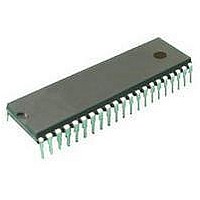ST72C334N2B6 STMicroelectronics, ST72C334N2B6 Datasheet - Page 16

ST72C334N2B6
Manufacturer Part Number
ST72C334N2B6
Description
Microcontrollers (MCU) Flash 8K SPI/SCI
Manufacturer
STMicroelectronics
Datasheet
1.ST72C334N2T6.pdf
(126 pages)
Specifications of ST72C334N2B6
Data Bus Width
8 bit
Program Memory Type
Flash
Program Memory Size
8 KB
Data Ram Size
384 B
Interface Type
SCI, SPI
Maximum Clock Frequency
8 MHz
Number Of Programmable I/os
44
Number Of Timers
16 bit
Operating Supply Voltage
3.2 V to 5.5 V
Maximum Operating Temperature
+ 85 C
Mounting Style
Through Hole
Package / Case
SDIP-56
Minimum Operating Temperature
- 40 C
On-chip Adc
8 bit
Lead Free Status / Rohs Status
No
Available stocks
Company
Part Number
Manufacturer
Quantity
Price
Company:
Part Number:
ST72C334N2B6
Manufacturer:
ST
Quantity:
365
ST72334J/N, ST72314J/N, ST72124J
2.4 FLASH PROGRAM MEMORY
2.4.1 Introduction
Flash devices have a single voltage non-volatile
FLASH memory that may be programmed in-situ
(or plugged in a programming tool) on a byte-by-
byte basis.
2.4.2 Main features
2.4.3 Structural organisation
The FLASH program memory is organised in a
single 8-bit wide memory block which can be used
for storing both code and data constants.
The FLASH program memory is mapped in the up-
per part of the ST7 addressing space (F000h-
FFFFh) and includes the reset and interrupt user
vector area .
2.4.4 In-Situ Programming (ISP) mode
The FLASH program memory can be programmed
using Remote ISP mode. This ISP mode allows
the contents of the ST7 program memory to be up-
dated using a standard ST7 programming tools af-
ter the device is mounted on the application board.
This feature can be implemented with a minimum
number of added components and board area im-
pact.
An example Remote ISP hardware interface to the
standard ST7 programming tool is described be-
low. For more details on ISP programming, refer to
the ST7 Programming Specification.
Remote ISP Overview
The Remote ISP mode is initiated by a specific se-
quence on the dedicated ISPSEL pin.
The Remote ISP is performed in three steps:
Remote ISP hardware configuration
In Remote ISP mode, the ST7 has to be supplied
with power (V
cillator and application crystal circuit for example).
16/125
Remote In-Situ Programming (ISP) mode
Up to 16 bytes programmed in the same cycle
MTP memory (Multiple Time Programmable)
Read-out memory protection against piracy
– Selection of the RAM execution mode
– Download of Remote ISP code in RAM
– Execution of Remote ISP code in RAM to pro-
gram the user program into the FLASH
DD
and V
SS
) and a clock signal (os-
This mode needs five signals (plus the V
if necessary) to be connected to the programming
tool. This signals are:
If any of these pins are used for other purposes on
the application, a serial resistor has to be imple-
mented to avoid a conflict if the other device forces
the signal level.
Figure 6 shows a typical hardware interface to a
standard ST7 programming tool. For more details
on the pin locations, refer to the device pinout de-
scription.
Figure 6. Typical Remote ISP Interface
2.5 Program Memory Read-out Protection
The read-out protection is enabled through an op-
tion bit.
For FLASH devices, when this option is selected,
the program and data stored in the FLASH memo-
ry are protected against read-out piracy (including
a re-write protection). When this protection option
is removed the entire FLASH program memory is
first automatically erased.
– RESET: device reset
– V
– ISPCLK: ISP output serial clock pin
– ISPDATA: ISP input serial data pin
– ISPSEL: Remote ISP mode selection. This pin
C
L0
must be connected to V
board
SS
XTAL
ST7
: device ground power supply
C
L1
ISPDATA
ISPSEL
ISPCLK
RESET
TO PROGRAMMING TOOL
HE10 CONNECTOR TYPE
V
SS
SS
on the application
10k
APPLICATION
DD
4.7k
signal
1
1













